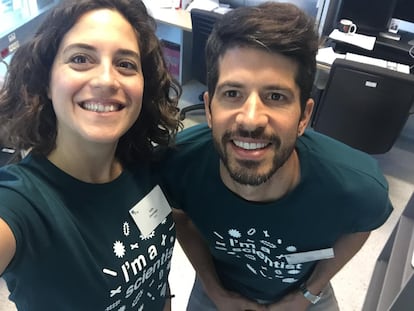Four years before winning the Nobel Prize for Medicine, the French biologist Jacques Monod stood one night in 1961 in the laboratory of a colleague and, with a tired face and after a few minutes of silence, proclaimed: “I think I have discovered the second secret of the life".
His partner, microbiologist Agnes Ullmann, asked him if he needed a glass of whiskey.
After the third glass, Monod explained that he had observed an amazing phenomenon: proteins, the true protagonists of living matter, had a kind of hidden buttons that changed their function.
Monod had even invented a word to define that amazing transformation: allosterism.
More than half a century later, a team of scientists from Barcelona has discovered a method to identify those secret buttons.
Human cells have inside them a recipe book —DNA, the first secret of life— to make proteins: the keratin of the skin, the collagen of the bones, the myosin of the muscles, the hemoglobin of the blood.
Simple molecules are easy to imagine, like the alcohol in the whiskey that Jacques Monod drank, which has two carbon atoms, six hydrogen atoms, and one oxygen: C₂H₅OH.
Proteins, on the other hand, are often incomprehensible chemical monsters.
The formula for hemoglobin is C₂₉₅₂H₄₆₆₄N₈₁₂O₈₃₂S₈Fe₄.
In the lungs, this giant binds to oxygen, causing a change in its three-dimensional structure that makes it easier for more oxygen to bind elsewhere.
It is an example of allosterism, a word with a Greek root that could be translated as “another structure”.
A team from the Center for Genomic Regulation (CRG), in Barcelona, has now illuminated this second secret of life.
Biologist Júlia Domingo compares proteins to a microscopic car, which can be started with the ignition key, but also by means of "remote controls" hidden in the bodywork.
“It's hard to know where to look for them.
Our method is to take the car and scrap it.
We take out all the pieces and analyze them one by one”, explains Domingo, now at the New York Genome Center (USA).
The Spanish biologist Júlia Domingo and the South African bioinformatician André Faure.Júlia Domingo
The new technique creates thousands of versions of the same protein, with one or two mutations, and checks their properties automatically in living cells.
The result is a map of presumed secret buttons, the so-called allosteric sites, which could be used to modify the function of proteins through drugs.
The CRG team, led by British biologist Ben Lehner, publishes its method this Wednesday in the journal
Nature
, the showcase of the best world science.
Júlia Domingo gives an example.
Proteins called KRAS, considered immune to drugs for decades, are mutated in 95% of pancreatic cancer cases because they lack obvious binding sites.
The authors are already applying their method to these proteins and others of similar importance, to try to find their secret buttons.
“Normally, drugs are designed with a very random and serendipity process.
Companies start with hundreds of thousands of candidates, without really knowing what they are doing”, explains Domingo.
“Our objective is to make a map of the allosteric sites, to know what properties the drugs should have.
Instead of starting blindly, we will know where to direct the drugs”, celebrates Domingo.
Proteins usually have an obvious starter key, the active site, which can be acted upon like a switch.
The big problem for medicine is that the active sites of different proteins are very similar, so drugs that target these sites can alter a multitude of proteins, causing serious side effects.
Allosteric drugs, directed at the secret buttons, are much more specific, explains Domingo, the first signatory of the study together with the South African bioinformatician André Faure and the German biophysicist Jörn Schmiedel.
“It is the holy grail of pharmaceuticals”
Julia Domingo, biologist
A multitude of biotech companies have launched in recent years to search for these hidden doors of proteins.
The American company Relay Therapeutics, for example, has obtained almost 1,000 million dollars (917 million euros) to investigate potential allosteric drugs against some tumors, such as breast cancer.
“It is the holy grail of drugs”, declares Júlia Domingo, born in Barcelona 31 years ago.
One of the main scientific achievements of 2021 was that an artificial intelligence system, from Google's DeepMind company, managed to predict with unprecedented precision the structure of almost all the proteins that make up a human being.
The CRG scientists believe that their new method could be used to measure the effects of millions of mutations in thousands of proteins.
An artificial intelligence system, they hypothesize, could use this enormous amount of data to make another great leap: predict the function of a protein from its DNA recipe.
In the authors' opinion, this predictive capacity would “revolutionize” the development of medical treatments.
Spanish biophysicist Víctor Muñoz, from the University of California at Merced (USA), applauds the new method.
"It is a tool that can be useful to identify regions in the protein that are likely to be the target of a drug," he says.
Muñoz, however, is more cautious.
The researcher also uses the example of the car.
If the axis that connects the motor with the wheels is modified, the vehicle stops working, he points out.
That would be an allosteric change.
"If you remove a wheel, the car doesn't work either, but that's because it's missing a piece, not that you've touched something dynamically connected," Muñoz details.
In the biophysicist's opinion, the new method can reveal supposed allosteric sites that in reality are not.
“They do massive mutations and see that one has left the car inoperable, but they don't know if a wheel is missing or the axle has been modified.
You need more detailed information.
You can use this method to identify a potentially interesting area, but then a lot more work will have to be done to confirm it”, considers Muñoz, director of the Center for Cellular and Biomolecular Machines at the University of California.
The chemist Nuria Campillo directs Aitenea Biotech, a company dedicated to drug research and development, promoted by the Higher Council for Scientific Research.
Campillo believes the new method is "an impressive piece of work, a very elegant way of identifying allosteric sites."
In her opinion, the tool “will facilitate the discovery of more effective and safer drugs”.
The second secret of life is no longer so secret.
You can follow
MATERIA
on
,
and
, or sign up here to receive
our weekly newsletter
.









